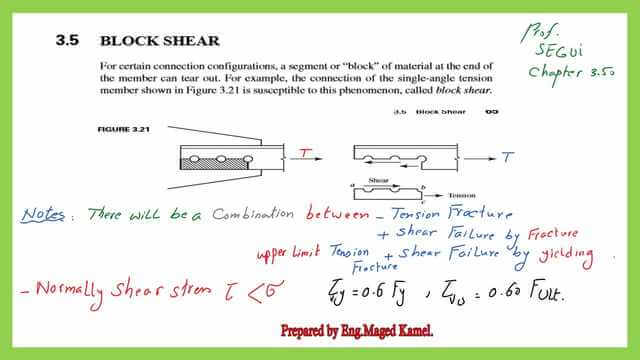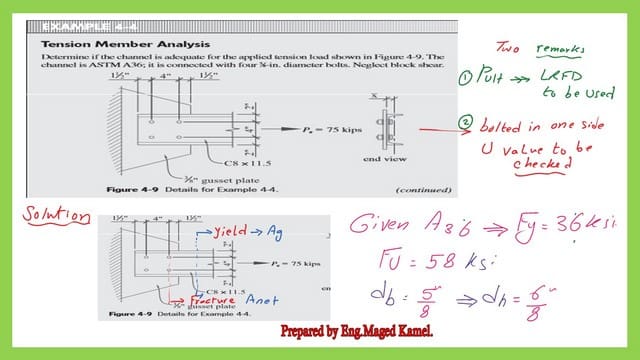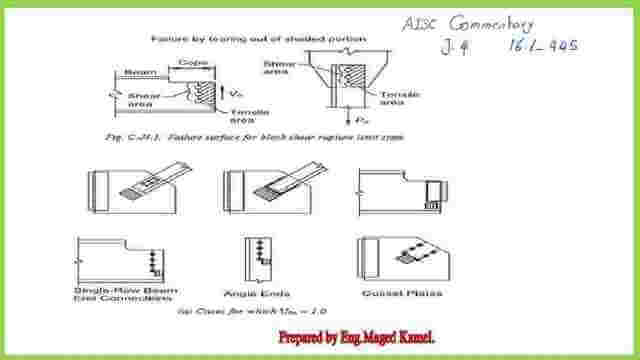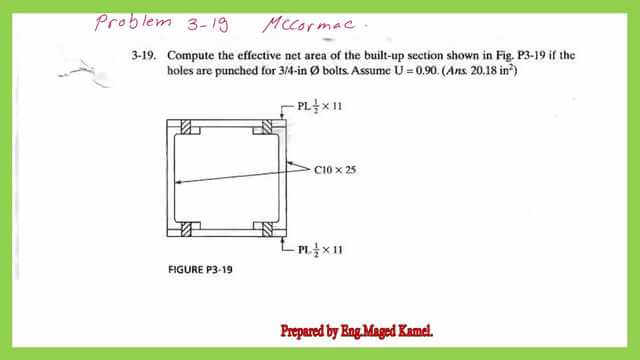Last Updated on July 20, 2025 by Maged kamel
List of Tension Members’ Posts- Part 3.
List of tension Member’s Posts-part 3 will start from post 10 to post 18.
- List of Tension Members' Posts- Part 3.
- Quick-start to the introduction to block shear.
- A solved problem 4-4, Pult without block shear.
- Solved problem 4-6- Pult with-block shear.
- Block shear and coped beams.
- A solved problem 5-7.
- Problem 3-7 for staggered bolt-tension members.
- Solved problem 3-8-1 for staggered Bolts.
- Problem 3-4-3 for staggered bolt-tension members.
- A solved problem 3-19-built-up section.
Quick-start to the introduction to block shear.
This is the 14th post. The first point of discussion concerns the slenderness value and l/r value for tension members. The second point concerns code provisions, the introduction of shear blocks, and the governing equations.

This is the link to post 10: Quick-start to the introduction to block shear.
A solved problem 4-4, Pult without block shear.
This is the 15th post, A solved problem -4-4, from Prof. Abi O. Aghayere ‘s book. Check the adequacy of the channel, without considering the block shear. Agivan Ultimate load of P=75 kips is acting on C8x11.50 connected to a gusset plate.

The link to post 11: A solved problem 4-4, Pult without block shear.
Solved problem 4-6- Pult with-block shear.
There are two posts, the 16th and 17th, a solved problem-4-6. From Prof. Abi O. Aghayere ‘s book. For Tension Member with Block Shear For the connection shown in solved problem 4-4.
Considering block shear, considering block shear, determine if the channel and gusset plate are adequate for the applied tension load. Post 12 details the Block shear value for the channel under tension load and illustrates whether the channel is sufficient.
This is the link to post 12: Solved problem 4-6-block shear for a C-Channel-1/2.
Post 12A provides a detailed estimate of the gusset plate block shear capacity. Estimations of Block shear strength for LRfd and ASd designs are also shown.
This is the link to post 12a: Solved problem 4-6-block shear for a C-Channel-2/2.
Block shear and coped beams.
This is the 18th post and includes a discussion of two items. The first item is a sample of the block shear, various patterns for a given section acted upon by a tension force.
The second part concerns the UBS values and a coped beam. Based on the cut places, the different names of coped beams are given from the AISC commentary.

This is the link to post 13: Block shear and coped beams.
A solved problem 5-7.
This is the 19th post. It includes solved problem 5-7 for block shear from Prof. Alan Williams’s book.
Determine the block shear strength of the connection shown in Fig. 5.5a.
Both members have a yield stress of 36 ksi and a tensile strength of 58 ksi. The tension member thickness is t = 1/2 in, the gusset plate thickness is tg = 1.0 in, and the bolts are 7/8 in diameter. The relevant dimensions are s = 3 in, g = 2 in, Leh = 2 in, and Lev = 2 in.
This link is to post 14: a solved problem 5-7 for block shear.
Problem 3-7 for staggered bolt-tension members.
The post will review the solved problem 3-7 for staggered bolt-tension members. This problem is quoted from Prof. Segui’s handbook. The main aim is to investigate the different failure roots of failures and the corresponding net areas.
This is the link to post 15: Problem 3-7 for staggered bolt-tension members.
Solved problem 3-8-1 for staggered Bolts.
The post will start by discussing the concept of load transfer by fasteners, with the estimation of the net area. This method is included in the solved problem as a final net area refinement.
A solved problem 3-8-1 for the staggered Bolt that was introduced in the textbook Steel Structures ,Fifth Edition by Salmon.
This is the link to post 15A: Solved problem 3-8-1 for staggered Bolts.
Problem 3-4-3 for staggered bolt-tension members.
The post will review the solved problem 3-4-3 for staggered bolt-tension members, which is quoted from Prof. Segui’s handbook. The main aim is to investigate the different routes and causes of failures and the corresponding net areas. The solved problem has two parts.
This is the link to post 16: Problem 3-4-3 for staggered bolts-tension members-1/2.
This is the link for post 17: Problem 3-4-3 for MC section-LRFD and ASD value-2/2.
A solved problem 3-19-built-up section.
A solved problem 3-19. Compute the effective net area for the given built-up section.

This is the link for post 18:The Effective Area for a Built-Up Section
This is a link to the list of tension members’ posts in part 1.
This is a link to the list of tension members’ posts in part 1A.
This is a link to the list of tension members’ posts in part 2.
An external source for tension members from Prof. T. Bartlett Quimby’s site, which is the Tension Member Overview based on CM#15.